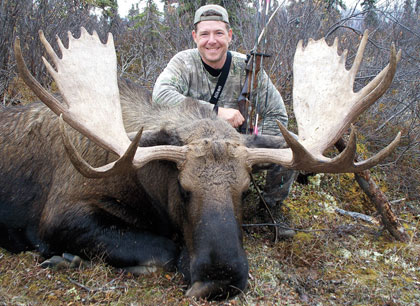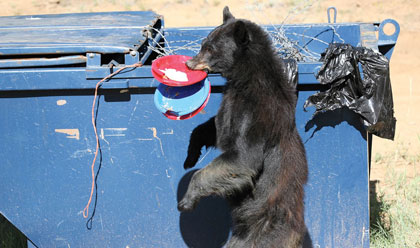March 16, 2011
By Fred Eichler
What do choosing a traditional bow and keeping bears out of your chicken house have in common? Everything!
By Fred Eichler

Advertisement
My 54-pound recurve has proven more than adequate to harvest any big game in North America. I've killed five bull moose with recurves of this draw weight. |
Advertisement
Two days ago a bear broke into our chicken coop, killing three of our chickens. I was a little ticked about that, although it did not surprise me since we'd been seeing a lot of bears around. We also had a bear crawl into our dumpster and drag trash all over the place. Interestingly, my wife, Michele, decided picking up bear-strewn trash and protecting chickens falls under my job description. My solutions were to install an electric fence around the chicken coop and a locking bar on top of the dumpster. The downside was I had to replace three chickens and spend half a day picking up trash because I hadn't anticipated the problems or done anything to prevent them.
I share this story because it's a little like buying a traditional bow. You can avoid a lot of unnecessary problems by taking a few precautions and doing some research before jumping in. I've seen guys totally give up on shooting a recurve or longbow because their first experience was all negative. The following precautions and suggestions will ensure your bow-buying experience is a positive one.
Bow Weight
For years I managed an archery shop in northern Colorado and, in my opinion, most traditional bowhunters make the mistake of shooting too much draw weight. I know quite a few experienced hunters who will never shoot very accurately because they are trying to shoot too much poundage.
Standing 6'2" and weighing 205 pounds, I'm probably stronger than the average 40-something guy. Yet I shoot only 54 pounds at my draw length. I can certainly draw more weight, but 54 pounds is a very comfortable weight for me. I can pull it smoothly and easily and hold it at full draw for 10 seconds if I need to wait for a shot. I've killed five moose and 11 elk with my recurve at that draw weight, and it has always proven more than adequate. I wouldn't hesitate to hunt elk with a 45-pound bow if that is all I could draw comfortably.
If you're used to shooting a compound bow, I advise that you start out with a traditional bow 15 pounds lighter than the peak weight of your compound. For example, if you're comfortably shooting a 65-pound compound, I would suggest a 50-pound longbow or recurve at your draw. "At your draw" means the bow has approximately 50 pounds of draw weight at your natural draw length. Most recurves or longbows have a weight listed on the riser or limbs. This poundage is measured at 28 inches. If you buy a manufactured bow listed as 55 pounds and draw it to 27 inches, you'll be pulling less than 55 pounds at your draw length. If you draw it over 28 inches, you'll be pulling more than 55 pounds. As a rule of thumb, most stickbows gain 2½ to 3½ pounds of weight per inch drawn past 28 inches and lose about the same for every inch less than 28 inches. This weight gain and loss works for draw lengths from 25 to 31 inches. For draw lengths outside of that range, the gains/losses become greater.
Don't get me wrong -- some guys shoot heavy poundage just fine, but they are the exception. There's also a misconception you need more than a 55-pound traditional bow to cleanly kill big game. That's not true. Lighter bows are easier to draw, easier to hold at full draw, and easier to practice with for long hours. So, when choosing poundage on a traditional bow, go light and comfortable. You'll harvest more game.
Bow Length
Choosing the length of your bow can be very confusing for a beginner or even some experienced traditionalists. Most recurves commonly come in lengths of 58, 60, and 62 inches. The old rule was if you had a short draw length, less than 28 inches, you should shoot a 56 or 58-inch bow. For 28 to 29½-inch draw lengths, a 60-inch bow would perform best. For draw lengths over 29½ inches, a 62-inch bow would be the best choice. I've found 60 inches to be a happy medium. Longbows range from 60 inches at the short end to 70 inches on the long end. I would consider 64 inches to be a happy medium.

|
Some people have multiple bows for different situations. For example, I have friends who prefer super-short recurves or longbows for hunting from blinds but longer bows when stalking and medium-length bows when in a treestand. Really, bow length boils down to personal preference and what feels best in your hands. I advise going to a pro shop that has a good selection and trying bows of different lengths. If a bow feels good to you, ignore the length.
Custom vs. Manufactured Bows
This is a tough one, and a lot depends on how much money you want to spend. I'll start by saying all bows are not created equal. There's a huge difference between a well-made bow and a poorly made bow. I've shot both custom and manufactured bows that were terrible. I've also shot both types that were great. Fortunately, you can choose from a ton of great options.
For manufactured bows, a lot of the major compound companies are now offering traditional equipment. These bows average about half the cost of custom bows. I've shot Hoyt, Bear, and PSE recurves I was tickled with. I've also shot Bear and Martin longbows that performed very well.
On the custom side, I've shot some great bows, and I've shot others that weren't worth $50. Custom bows do have their advantages. Well-made models are great performers, and each bow is truly a work of art made to your specifications. If you order a custom bow, trust the bowyer and listen to his or her suggestions on bow length and materials.
There are literally hundreds of custom bowyers, so do some research before laying down any money. I haven't shot them all but some custom recurves I've been impressed with include Palmer, Horne, Stalker, Foley, and Robertson. Custom longbows I've liked include Toelke, Robertson, and Great Northern.
One thing you should always consider is the warranty. If a company, whether a large manufacturer or a one-man custom operation, isn't willing to back its products, don't take the chance. Go with one that believes in its bows and is willing to back them.
Hiding Your Purchase
Probably the most informative part of this column is my advice on how to hide your new purchase from your significant other. I've tried every excuse in the book, and these are some that have worked for me in the past. I say "past" because Michele reads Bowhunter Magazine, and I'm sure this part of the article will tip her off. Bu
t I feel that the needs of the many outweigh the needs of the few -- in this case me. Try one or a combination of the following lines to cover your tail. The key is not to admit you've actually spent any money.
1) This old thing? I've had it for years.
2) I found it while hunting, and I will only keep it until I find the owner.
3) My friend (fictitious name) died and left it to me. Note: With this one, try to get a tear in your eye. Pulling nose hairs works for me.
4) An old girlfriend gave it to me. Note: This is great because your wife will never ask about the bow again. You do, however, have to worry about her using your new bow for kindling in the fireplace.
As always, good luck in your hunting, and have fun.

